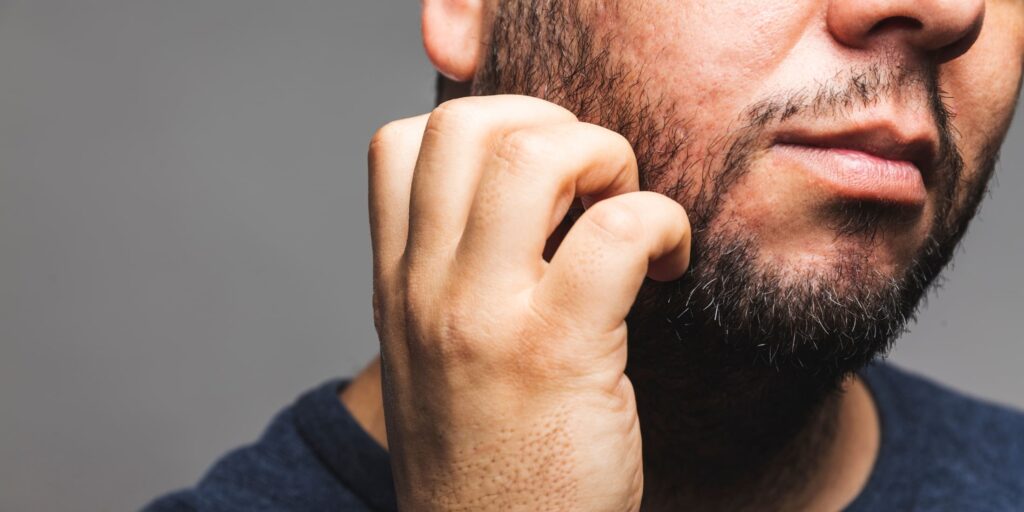The 2-week beard growth stage is an exciting and crucial part of your beard-growing journey. During these first two weeks, you’ll encounter minimal growth initially, increasing itchiness, and potential patchiness.
Understanding what to expect and how to care for your beard during this phase is essential for setting a strong foundation. With the right tips and a bit of patience, you’ll soon see your beard take shape, reflecting your unique style.
Understanding the 2-Week Beard: Growth Expectations
Embarking on a beard-growing journey is both exciting and challenging. The 2 week beard growth stage is crucial as it sets the foundation for your future beard.

Here’s what to expect and how to navigate these early growth days.
Growth Expectations
- Day 1-3: Minimal difference from usual stubble; skin may feel rough.
- Day 4-7: Beard becomes more visible, itchiness increases—normal and temporary.
- Day 8-14: Beard looks fuller, though still short; natural growth pattern and potential patchy areas become noticeable.
Key Points:
- Itchiness is common but temporary.
- Patchiness is normal and often fills in over time.
- Growth rate varies for everyone.
Now, let’s talk about the appearance and how to navigate the early growth phase of your 2 week beard.
What to Expect
- Patchy Areas: Common and often fill in with time and care.
- Color Variations: Adds character and uniqueness.
- Length: Typically around ¼ inch long.
Did You Know?
- Facial hair grows about half an inch per month on average.
- Genetics play a significant role in beard growth patterns.
By understanding these 2 week beard growth expectations and navigating the early stages, you’ll set yourself up for beard-growing success.
Remember, every great beard started with a few weeks of stubble. Stick with it, and soon you’ll be sporting a beard to be proud of!
Overcoming the Early Stage Beard Itch: Managing Discomfort
Dealing with itchiness is a common challenge during the 2-week beard stage. Here’s how to manage it effectively.

Why Does Your 2 Week Beard Itch?
- New Hair Growth: New hairs can irritate the skin.
- Dry Skin: Lack of moisture leads to dry, flaky skin.
- Trapped Dirt and Oils: Accumulation of dirt and oils causes irritation.
Tips to Soothe the Itch
- Moisturize Regularly:
- Use beard oil daily to hydrate skin and beard.
- Apply after washing to lock in moisture.
- Wash Your Beard:
- Use a gentle beard wash 2-3 times a week.
- Rinse thoroughly to remove any residue.
- Exfoliate Your Skin:
- Gently exfoliate the skin under your beard once a week.
- This removes dead skin cells and reduces flakiness.
Did You Know?
- Natural Ingredients: More effective and less irritating than synthetic ones.
- Beard Oil: Soothes itch and promotes healthy beard growth.
By following these tips, you can manage and overcome the itchiness of your 2-week beard, making your beard-growing journey more comfortable and enjoyable.
Stick with it, and you’ll soon move past this phase with a healthy, growing beard!
Essential Grooming Tips for Your 2-Week Beard
Proper care is key to a great-looking and comfortable 2 week beard beard. Follow these essential grooming tips to keep it clean, hydrated, and soft.
Clean Your Beard
- Wash Regularly: Use our gentle beard wash 2-3 times a week. Avoid harsh soaps that can dry out your skin and hair.
- Rinse Daily: On non-shampoo days, rinse your beard with lukewarm water to remove dirt and sweat.
Hydrate Your Beard
- Apply Beard Oil: Use a few drops of this beard oil daily to moisturize your beard and the skin underneath. This helps prevent dryness and itchiness (common at the 2 week mark).
- Massage It In: Gently massage the oil into your beard, ensuring it reaches the skin. This improves blood circulation and promotes healthier growth.
Soften Your Beard
- Condition Regularly: Use a beard conditioner or a leave-in conditioner a few times a week to keep your beard soft and manageable.
- Brush Daily: Use our best-selling beard brush to distribute natural oils from your skin throughout your beard. This not only softens the hair but also trains it to grow in your desired direction.
Benefits of Following These Tips:
- Cleanliness: Prevents skin irritation and ingrown beard hairs, promoting a healthier beard.
- Hydration: Makes your beard look shinier, feel softer, and reduces the risk of beard dandruff.
- Softness: Reduces the risk of breakage, leading to a fuller, healthier beard over time.
By following these grooming tips, your 2-week beard will not only look great but also feel fantastic. Stick with these grooming tips, and you’ll be well on your way to a magnificent beard!
Shaping Your 2-Week Beard
The 2-week beard stage is perfect for starting to shape your beard. Establishing a good shape early sets the foundation for a stylish look. Here’s how to get started.
Why Shape Your Beard Early?
- Foundation: Early shaping defines your beard’s future look.
- Neatness: Keeps your beard tidy and intentional.
- Confidence: A well-shaped beard boosts confidence during awkward growth phases.
Key Areas to Shape
- Neckline:
- Draw an imaginary line from ear to ear above your Adam’s apple.
- Shave everything below this line.
- Cheek Line:
- Follow the curve of your cheekbones.
- Clean up stray hairs above this line.
Tools You’ll Need
- Scissors: For precise trimming and maintenance.
- Razor: For a close shave around the neckline and cheek line.
- Boar Bristle Beard Brush: To evenly distribute hairs before trimming.
Steps to Shape Your Beard
- Define Your Neckline:
- Tilt your head back and visualize or draw your neckline.
- Trim or shave everything below this line.
- Shape Your Cheek Line:
- Smile to see the natural curve of your cheekbones.
- Trim or shave stray hairs above this line.
- Tidy Up Stray Hairs:
- Use scissors to clean up any stray hairs along the edges.
Pro Tip: Take your time. It’s better to remove too little hair than too much.
Did You Know?
- Consistent Shaping: Trains your beard to grow in a specific direction.
- Regular Trimming: Maintains the desired shape and prevents an unkempt appearance.
By shaping your 2-week beard with care, you set the stage for a stylish, well-groomed beard. This small investment of time pays off as your beard grows and matures. Enjoy the process and watch your beard transform!
Common 2-Week Beard Problems
Growing a 2-week beard is exciting but comes with challenges other than itchiness. Here’s how to tackle other common issues with a 2 week beard:
Patchiness
- Be Patient: Hair grows at different rates; patches often fill in.
- Brush and Train: Use our beard brush to train your hairs.
- Healthy Diet: Eat a balanced diet rich in vitamins and minerals.
Dry Skin
- Hydrate: Drink plenty of water.
- Moisturize: Use our natural beard oil to keep skin hydrated.
- Avoid Hot Water: Use lukewarm water to preserve natural oils.
Uneven Growth
- Trim Sparingly: Neaten edges without over-trimming.
- Brush Daily: Train beard to grow uniformly.
- Use Beard Products: Manage unruly hairs with beard oil.
Ingrown Hairs
- Exfoliate Regularly: Remove dead skin cells to prevent trapped hairs.
- Moisturize: Keep skin soft to reduce ingrown hairs.
- Avoid Shaving: Prevent ingrowns by not shaving too close.
By addressing these common 2-week beard problems, you’ll be on your way to a healthy, attractive beard. Embrace the journey with patience and proper care!
Growing a 2 week beard comes with lots of questions. Whether you’re new to beard growth or looking for some reassurance, here are answers to common questions.
How Much Can a Beard Grow in 2 Weeks?
- Average Growth: 0.125 to 0.25 inches.
- Factors: Genetics, age, diet, and health influence growth rate.
- Fact: Growth rates vary; both fast and slow progress are normal.
What Should My Beard Look Like After 2 Weeks?
- Appearance: Short beard, 0.125 to 0.25 inches long.
- Texture: May be uneven and patchy.
- Density: Early signs of your natural growth pattern.
- Pro Tip: Use a beard brush to train growth and keep it neat.
When Does the Awkward Stage Start for a Beard?
- Timing: Begins around 2 to 4 weeks.
- Characteristics: Marked by patchiness, uneven growth, and itchiness.
- Duration: Lasts a few weeks to a couple of months.
- Did You Know? The awkward stage is temporary. With patience and care, your beard will fill in.
By addressing these common questions, you can better navigate your 2-week beard journey. Remember, every beard grows at its own pace. Keep grooming, stay patient, and enjoy watching your beard grow.
Conclusion
Growing a 2-week beard is an exciting adventure filled with growth, challenges, and learning. As you navigate this early stage, remember that patience and proper care are your best allies.
Key Takeaways for Your 2-Week Beard
- Embrace the Itch: Itchiness is temporary. Use beard oil and moisturizer to soothe your skin.
- Manage Patchiness: It’s normal. Give it time, and use a beard brush to train the hair.
- Stay Hydrated: Both your body and beard need hydration. Drink water and apply beard oil regularly.
- Gentle Washing: Clean your beard with a gentle beard wash 2-3 times a week. Rinse with lukewarm water on non-shampoo days.
- Shape Early: Define your neckline and cheek line early to set a good foundation.
- Healthy Lifestyle: A balanced diet rich in vitamins and minerals promotes healthier beard growth.
Tips for a Successful Beard Journey
- Consistency is Key: Stick to a daily grooming routine.
- Be Patient: Good things take time, including a magnificent beard.
- Experiment with Products: Find what works best for your skin and beard type.
- Learn and Adapt: Stay informed about beard care and adapt your routine as your beard grows.
Remember, every beard is unique. The 2-week beard stage is just the beginning. With proper care, patience, and a positive mindset, you’ll soon transition from stubble to a fuller, more defined beard. Enjoy the process, learn from each phase, and take pride in your progress.
Stick with it, and you’ll soon be sporting a beard to be proud of!





